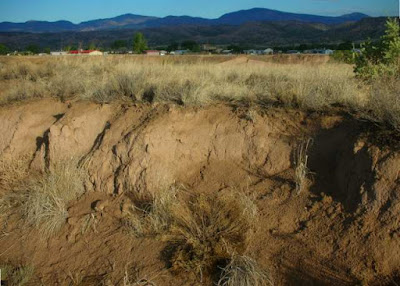Wednesday, October 10, 2018
Running Water
[I originally wrote this in October 2011, but never posted this series on the local geology. The pictures are still worth seeing. Hurricane Rosa in the Pacific probably contributed to our moisture last week. The current Atlantic hurricane, Michael, is near the Florida panhandle.]
Another hurricane in the western Caribbean, some more rain this morning.
We’re past the danger point this year, when water is a potential enemy. In late summer, before the first rain after a long drought, you worry the ground has become too hard to absorb water and it will run off the surface. Firefighters were especially concerned about Santa Clara canyon where heat from the Las Conchas fire had baked the soil.
When I first moved here, I could be flooded when water coming off the hill turned into a rolling sheet that gathered force as it moved, fed as it was, every inch, by more rain. Water poured through the joints in my the rail-tie retaining wall, until I stuffed broken tiles behind the cracks.
My uphill neighbor had worse problems. He’d built his house in an abandoned road bed which channeled the water his way. A few years ago, he got a backhoe and built a bunker behind his property which diverted the flow of water enough that I no longer was in its path.
At the corner of my property, the paved road makes a sweeping turn. People who live downhill regularly had their garages flooded as water running down the road, swollen by feeds from every driveway uphill, flowed down their drives. One year, a number of people also had their well houses inundated.
The curve is actually an intersection of three roads - or so the people who numbered the roads believed. The compacted dirt ranch road, which branches from the curve, also collects water from the paved road and sends it along the side of my property.
From there it flows towards the arroyo, collecting water from every break in its banks made by an ATV. This summer I could see where the water had penetrated from the surface, and where it has also been absorbed at the base, with a dry band between the two zones.
The ranch road continues on the other side, which means it feeds water into the arroyo from both sides.
I’m beginning to think one reason the arroyo is as wide as it is in that area is that the load of water has washed away more of the banks downstream. Since the water from the road would turn as soon as possible, it would move along the walls while the water coming from upstream would continue its path somewhere in the center.
Chamisa has taken advantage of the different flow rates to colonize the dryer areas between the banks. This has created the widened arroyo composed of platforms at the edges with some vegetation that drop into obvious water channels that move along two sides of islands anchored by chamisa.
Pictures
1. Ranch road going through the arroyo, 10/20/11, from top of the left bank; ATV tracks enter the arroyo on both sides of the curving road; my house is the one with the gray-white roof.
2. Hill behind my uphill neighbor’s house which is elevated on the right by the abandoned road bed marked by the fence posts. The berm runs parallel to the house.
3. Water running down hill between dead grasses on the west side of my house to drain into the ranch road, 8/21/11.
4. Bank of ranch road, 8/21/11.
5. Arroyo bottom, 9/11/11, from the platform at the base of the right bank.
Subscribe to:
Post Comments (Atom)





No comments:
Post a Comment